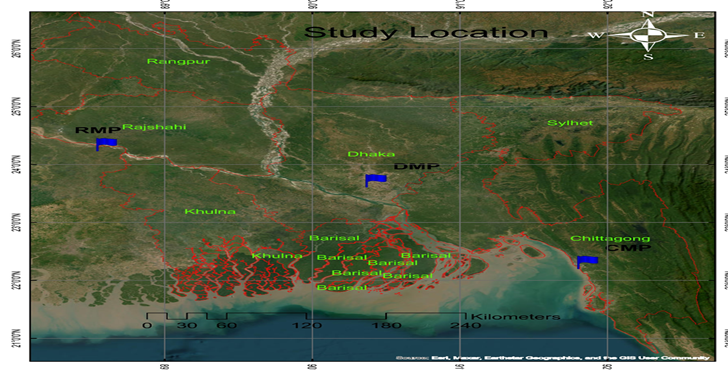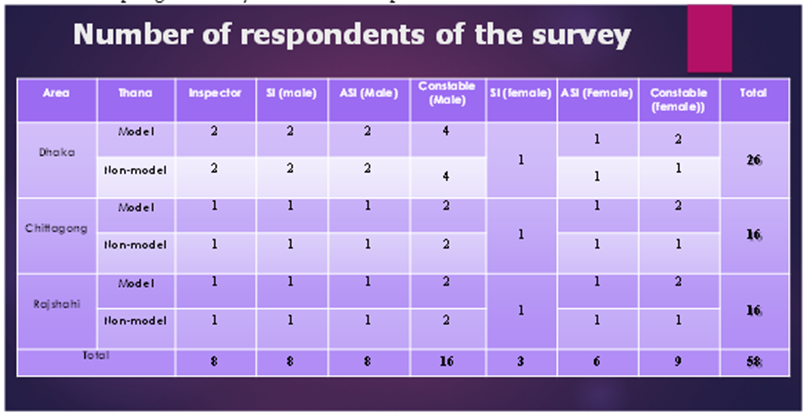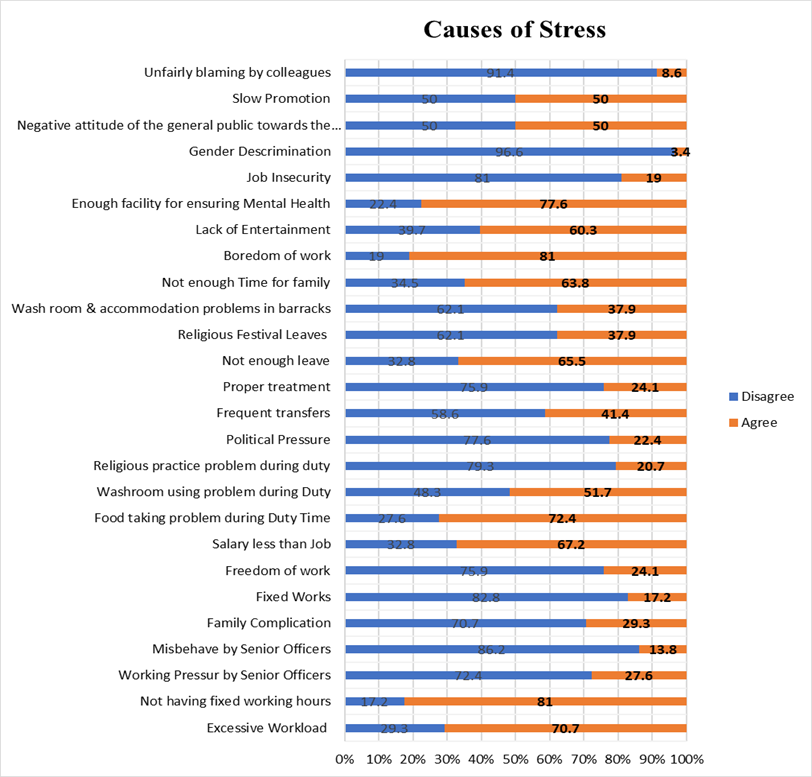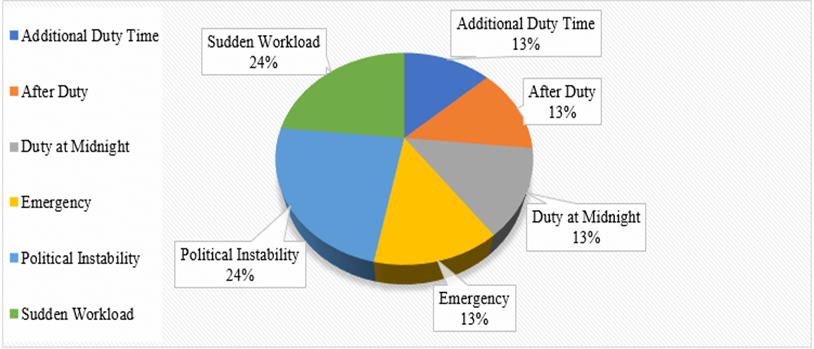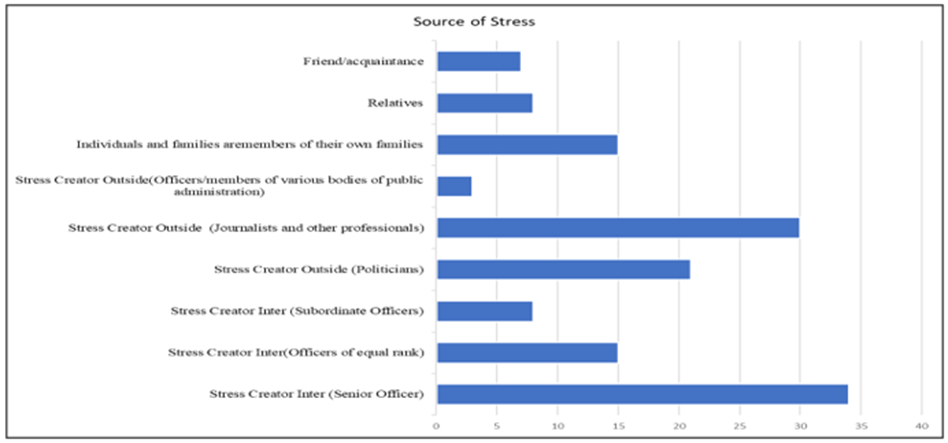Research Article
Aetiology of Stress among Police Forces
1Additional Inspector General of Police (Special Branch), Bangladesh Police.
2Director (Research & Publication), Police Staff College Bangladesh.
*Corresponding Author: Mohammad Shahjahan, Director (Research & Publication), Police Staff College Bangladesh.
Citation: Islam M, Shahjahan M. (2024). Aetiology of Stress among Police Forces, Clinical and Laboratory Research, BioRes Scientia Publishers. 2(1) :1-5. DOI: 10.59657/2994-6441.brs.24.009
Copyright: © 2024 Mohammad Shahjahan, this is an open-access article distributed under the terms of the Creative Commons Attribution License, which permits unrestricted use, distribution, and reproduction in any medium, provided the original author and source are credited.
Received: April 08, 2024 | Accepted: May 01, 2024 | Published: May 15, 2024
Abstract
No human being can deny stress but format is different. The study focuses on aetiology of police stress of Bangladesh. Because there has been so little research done on the topic, virtually everything about the situation in Bangladesh is a mystery. As a direct consequence of this, the perception and situation of the Bangladeshi police force are unknown and unexperienced in the area of police policy-making in many different ways. For the purpose of figuring that out, a limited study was carried out in the metropolitan area. In this region, in addition to the district police, the metropolitan police played a significant role in the upkeep of internal peace and security, and as a result, they were faced with a variety of problems and issues that needed to be figured out. This limited study was carried out in the metropolitan area. This initiative was carried out as part of this study in the three most important metropolitan areas of Bangladesh, all of which are places in Bangladesh where factors such as education level, gender, the scale and pressure of work, and job designation all play important roles in determining whether or not someone is stressed. Slow promotion, negative attitude of the general public towards the police, enough facility for ensuring mental health, lack of entertainment, boredom of work, not enough time for family, not enough leave, food taking problem during duty time, not having fixed working hours and excessive work load were the key causes of stress among police forces. Scope of recreational activities and psychological counselling can be instituted properly.
Keywords: stress; police; aetiology
Introduction
Positive stress inspires a human being to do his job properly but the negative stresses burden and sufferings has known no bound. It is hard to determine precisely when the history of the stress concept begins (for an overview, see e.g., Kugelmann, 1992; Doublet, 2000; Cooper and Dewe, 2004; Jackson, 2013). Predecessors like George M. Beard’s “neurasthenia” or Walter B. Cannon’s idea of “homeostasis” can be traced back to the end of the nineteenth and beginning of the twentieth century (Beard, 1869; Cannon, 1929). Note, that the “godfather of stress,” Hans Selye, did not use the term stress in his first publication about the general adaptation syndrome (GAS; Selye, 1936). Although the GAS is generally considered the starting point for the development of his stress theory, it was not before the 1950s that stress was regularly adopted as a scientific term.
Bangladesh Police is the core law enforcement agency of Bangladesh under the ministry of home affairs and the most visible law enforcement agencies working for the well-being of society i.e., protecting human rights, preservation of public security, handling crimes and its prevention. But these functions maintain are not easy task and also challenging. The ratio of Bangladesh police compare to overall population is much less than could, not satisfactory. As per maintaining the rules and order, stress is a common phenomenon for Bangladesh police. But in the context of Bangladesh, it has not found satisfactory research about aetiology of police stress. Bangladesh police faces over workloads as per following duty rules or order. Every year many police officer has lost their capabilities of usual task, increasing physical disorder, serious injuries even killed, increasing family conflict, thinking suicidal attempt and so many trouble. Specially in the context of Bangladesh police, psychological health always in ignorance, only authority gives priority in physical health. We should not forget that both mental and physical health can ensure a better life which is important for doing better jobs. This study has been conducted to address causes of police stress of Bangladesh police.
Methods and materials
The study is based on mixed method approach both qualitative and quantitative method. Open ended questionnaire survey used as a primary methodological tool including explorations of concepts, perceptions and experiences of stress of service holders as well as higher authority specifically maintain the key of law and order of Bangladesh police. Primary data has been collected from the service holders (police) of Thana level in three metropolitan areas i.e., Dhaka, Rajshahi and Chittagong. The study area was predetermined. For effective and efficient research, the study area includes 3 metropolitan areas which were selected purposely. Both Model and non-model thanas were selected. Total 58 respondents of different level service holders i.e., Inspector, SI (male), ASI (Male), SI (female), ASI (Female), Constable (Male) & Constable (Female). As a mentioned before earlier the sample design was based on non-probability sampling methods that’s why purposive sampling method has been used to select sample size. It is mainly followed by the availability of respondents.
Figure 1: Study Location of the Area (Blue Flag)
Table 1: Sampling Frame by Number of Responders
Besides respondents, 24 persons of different categories like Additional IG, DIG, Additional DIG, SP, ASP, Retired police officer, Psychologists and Journalist has pointed to take interviews as a Key Informant Interviews (KII).
Table 2: Sampling Frame by the number of Key Informant Interviews (KII)
These tools have been used for primary data collection. Secondary data that’s Common sources of data for social science include censuses, information collected by government departments, organizational records and data, journals, newspapers, etc. These data were mainly collected for other research purposes and also for relevant news or information. Proper coding schemes have been used in the processing and analysis parts for the quantification of qualitative data. SPSS software was used for data analysis to ensure accuracy, validation, graphical presentation, and proper interpretation of a field analysis.
Results
Causes of stress
Slow promotion, negative attitude of the general public towards the police, enough facility for ensuring mental health, lack of entertainment, boredom of work, not enough time for family, not enough leave, food taking problem during duty time, not having fixed working hours and excessive work load were the key causes of stress among police forces. Unfairly blaming by colleagues, gender discrimination and misbehave by senior officers were the disagreed issues regarding causes of stress.
Figure 2: Causes of stress
Other causes being stressed
According to the respondent from the police department, in addition to the reasons that have already been mentioned, there are some other factors that can contribute to stress. These factors include an unexpectedly high workload, political instability, any time of emergency, duty at midnight, duty after duty, and additional duty time. These factors contribute to stress for police officers both while they are on duty and when they are off duty.
Figure 3: Other causes being stressed
Source of Stress
According to the police officers who participated in the survey, more than a third of the sources of stress are outside stressors that are unrelated to the police department and internal stressors that involve senior officers. Individuals, members of their families, and other family members aren't the only ones who contribute to stress; politicians and subordinate officers do, too.
Figure 4: Sources of stress
Discussion
Stress measurement differs from the contextual aspects i.e., place, age, profession, health, wealth and so many causes. Terry A. Beehr, Leanor, B. Johnson and Ronie Nieva (1995) researched on Occupational Stress police and coping strategies of Police and their Spouses with the basis of one hundred seventy-seven police officers and their spouses in two metropolitan areas in USA. This paper measured nine potential stress outcome or strain variables as police stress that’s assignment satisfaction, experienced stress, suicide thoughts, drinking, divorce potential, somatic com- plaints, emotional exhaustion, and depersonalization. The ratio was very alarming. Some respondents posted that stress could be linked to suicide. Basically, this paper prioritized coping strategies of both police offices and their spouses to develop themselves specially four coping activities engaging to mark experience stress that’s are problem-focused coping, emotion-focused coping, rugged individualism, and religiosity. This paper drew attention on the coping strategies of police officers and their spouse eliminating or reducing stress but lack of showing parameter’s that’s effective stress management interventions to incorporate primary prevention strategies for ensuring organizational environment, the individual, and the individual-organizational interface improvement. Nicole A. Roberts and Robert W. Levenson (2001) addressed the job stress of police impacted on marital interaction in police couples specially on working days. This report highlighted the impact of job stress and physical exhaustion on the physiological and subjective components of emotional responding during marital interactions between 19 male police officers and their spouses in USA. In this paper’s findings indicated heightened risk for poor marital outcomes and thus document an emotional mechanism of job stress. These exhaustions can be negatively impact towards marriage and their relationship. It has ended with an argument that job stress is far more toxic for marital interaction than is physical exhaustion. Through the article “After-effects of job-related stress: families as victims' (1982) Susan E. Jackson and Christina Maslach illustrated the effects of job stress on family life specially police professions. This paper flashed stress experience by the Maslach Burnout Inventory and expressing those officers who were experiencing stress were more likely to display anger, spend time off away from the family, be uninvolved in family matters, and to have unsatisfactory marriages. The family is counted the most sufferer as an effect of job stress. Hsiu-Chao Chen, Frank Huang-Chih Chou,et.al (2006) compared between Quality of Life and Depression for Police Officers in the context of Kaohsiung, Taiwan. They used 12 item Short Form Health Survey (SF-12) and the Disaster-Related Psychological Screening Test (DRPST) to assess the quality of life and prevalence of depression for 832 police officers in Kaohsiung. They showed the enormous job stress of police work. Police work tends to be regarded as stressful and dangerous because of exposure to confrontation, violence, traumatic incidents, and human misery, and even the possibility of being seriously injured or killed. These workloads may result in depression. This depression is highly correlated with work disability and poor quality of life. During conducting this study, there were some limitations which make some troubles to complete the study. Firstly, COVID-19 pandemic shrinks the mobility for reaching the respondents. As police have different duty time, it was difficult to collect the data from the study area due to availability of the forces due to their duty and at the same time, the shortage of time. Fund was also the major and prominent limitations during this study.
Conclusion
Number of aetiological factors were identified in terms of stress among police forces namely slow promotion, negative attitude of the general public towards the police, enough facility for ensuring mental health, lack of entertainment, boredom of work, not enough time for family, not enough leave, food taking problem during duty time, not having fixed working hours and excessive work load. Regular leisure and recreational activities and psychological support can reduce stress level.
References
- Hsiu-Chao Chen, Frank Huang-Chih Chou, et.al (2006). A Survey of Quality of Life and Depression for Police Officers in Kaohsiung, Taiwan. Quality of Life Research, 15(5): 925-932.
Publisher | Google Scholor - Nicole A. Roberts and Robert W. Levenson (2001). “The Remains of the Workday: Impact of Job Stress and Exhaustion on Marital Interaction in Police Couples”. Journal of Marriage and Family, 63(4):1052-1067.
Publisher | Google Scholor - Terry A. Beehr, Leanor B. Johnson and Ronie Nieva (1995), Occupational Stress: Coping of Police and Their Spouses, Journal of Organizational Behavior, 16(1):3-25.
Publisher | Google Scholor - Susan E. Jackson and Christina Maslach (1982), “After-Effects of Job-Related Stress: Families as Victims”, Journal of Occupational Behavior, 3 (1):63-77.
Publisher | Google Scholor

